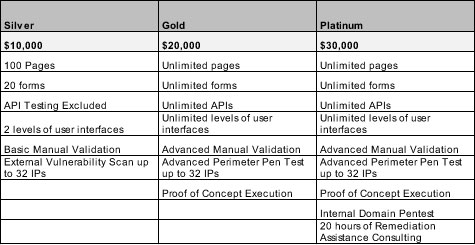The Fundamentals of Web App Penetration Testing
The Fundamentals of Web App Penetration Testing
First, let’s start with what a Web App Penetration Test is and list the different names and service synonyms that you may see that typically mean the same thing as a web app penetration test. A web app assessment, website application security testing, web app review, security testing for web applications, and several more all typically mean the same thing. Unlike a plain old pen test which typically refers to a network penetration test and is focused on the entire network; web app testing will focus only on the applications that are web-facing and most often exploited because they directly collect data from clients and customers.
Second, let’s define a web app test or web app pen test or security test for web applications (we won’t do this again but wanted to make sure you understood that these terms mean essentially the same thing…folks often get confused). A web application penetration test is an assessment of the security of the code and the use of software and libraries on which the application runs. Pen testers are security professionals that will search for vulnerabilities in web apps such as:
- Injection vulnerabilities
- Broken authentication
- Broken authorization
- Incorrect error handling
With so many organizations falling victim to cyber-attacks, IT security now must be willing to go beyond the network penetration test to secure internal and external web applications. Many organizations limit their security focus to vulnerability scans. However, scanning for software vulnerabilities and actually locating security failings in a web application through testing by simulating an attack will uncover critical vulnerabilities (not just software flaws) that can be exploited.
The bottom line is that while vulnerability scans can highlight software flaws or known weaknesses that can be found by scanners and patched simply by downloading code from a software manufacturer; web application penetration testing shows you how well they would hold up in a real-world attack by cybercriminals.
Thus, there is a significant difference between network penetration tests and web app penetration tests. Network penetration tests focus on the design, implementation, and maintenance of a network. It also looks at the services hosted on it. A web application pen test focuses more on applications and security protecting them, such as coding flaws and insecure use of the software.
What is a Web App Penetration Test?
Web applications are a critical component of doing business on the web. They first query a content database and generate a web document according to the specifications a client request. The information that is queried is presented in a way that it is accessible to all browsers, which run every script and make the document both readable and dynamic. Most web applications perform well out of the box or they can be purchased and customized to the needs of the organizations using fairly simple code to perform different queries.
Web-based attacks often lead to stolen credit cards, Social Security, or medical information. Web applications are particularly susceptible to attacks because they are available 24 hours a day, 365 days a year
Web-based attacks often lead to stolen credit cards, Social Security, or medical information. Web applications are particularly susceptible to attacks because they are available 24 hours a day, 365 days a year in most cases. And because these applications are publicly accessible, they are inherently not protected by traditional firewalls or SSL (though they may be protected by Web Application Firewalls (WAF’s).
The benefit of web penetration testing is that it specifically targets applications with browser-based clients. Today, this typically includes most of the applications used by organizations. Because of the wide use of web-based applications, web penetration testing should be a central part of any IT security program just as vulnerability assessments, risk assessments, and network pen testing are. Web-facing applications give cyber-criminals access to your customer’s personally identifiable information (PII), protected health information (PHI), intellectual property (IP), and often are the gateway to sensitive systems and other IT assets. As organizations have progressively moved their assets online and increasingly served their customers through their website, the threat of an attack against a web-based client has increased significantly over the past several years.
Further, software developers are focused on creating a compelling software product and rarely create software with security in mind. Thus, most applications have security vulnerabilities out of the box. In addition, vulnerabilities can often be introduced into the application through poor coding practices lack of authentication, and other issues that expose the application to attack.
Finally, web app testing is critical because even organizations with good vulnerability management such as timely patching processes have security gaps because attackers are constantly evolving their methods and creating new exploits or malicious code that will target unknown vulnerabilities in the software. Penetration testing can ensure your web applications are able to withstand an attack or at the very least, limit the damage an attacker can do.
What Does Web App Testing Actually Test?
Web App Penetration Testing tests all the links in web pages, the database connection, forms used for submitting or getting information from the user in the web pages, cookie testing, and much more.
Web Application Penetration Tests are typically offered by levels and include:
- Web Form Testing
- Web Page Testing
- API Testing
- User Interface Testing
- Internal Domain Penetration Tests
- External Vulnerability Scans
- Remediation Assistance
- Comprehensive Reporting
- Perimeter Penetration Testing
The list of activities or services included differs from company to company and they may be packaged differently. Some security service companies limit their services to a simple scan and form or page testing, while others provide a comprehensive package of services designed to uncover and remediate any and all vulnerabilities including poorly designed software.
Conclusion
Just like vulnerability assessments and penetration tests, web app pen tests are offered by countless organizations and vary in scope and pricing dramatically. The massive variation in service scope is a good thing, sort of. Let me explain; some organizations need help with scanning their web apps for vulnerabilities which is pretty basic, other organizations need help with eliminating vulnerabilities, testing the functionality of the application, improving accessibility, and even review the actual application code.
Here are a variety of fundamental questions you can ask your IT and IT security teams to understand your specific web app testing needs:
- Is the website secure?
- Is the website functioning as expected?
- Will customers find the website intuitive to navigate?
- Is the website accessible on mobile, desktop, tablet, etc.?
- Are the website speed and page load times fast enough?
- Is the data entered on a website stored accurately and persist across sessions?
- Is the website integrated well with other interfaces in the workflow?
SecureOps wants to be as transparent as possible with our menu of Web Application Penetration Test services so we listed the components and pricing below for your convenience. Our cybersecurity experts are focused on the distinct needs of our customers and strive to make certain that your web app’s ability to stand up to inside and outside security threats is excellent. We will handle the following so that your business, customers and employees are protected:
- Find security flaws in your web environments
- Highlight potential risks to your organization
- Help you map out a path toward addressing and repairing any identified flaws
To Learn More About How Web Application Penetration Testing Will Help Protect Your Business or If You Have Been Attacked Please Call Us – as Always, We Are Happy to Help – 1 (888) 982-0678.
You Can Also Fill Out Our Contact Us Form Here to Talk with a Security Specialist – https://secureops.com/contact-us/







